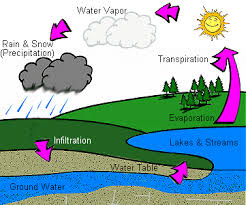Do you build models of the watershed in your classroom? As part of our unit on natural resources, we teach students the importance of watersheds, forests, and mineral resources. We are responsible for teaching the students about what a watershed is and how humans impact it.
 So to start, we teach students what a watershed is. They are all familiar with the water cycle model. I use this to start as they can connect what they already know to something new. When looking at this model I point out that water runs downhill towards a body of water. When they ask, what about the water that just soaks into the ground - I remind them of ground water. Where I live we don't have city water - not even at our school! We are very familiar with well systems...so they understand that there is water underground.
So to start, we teach students what a watershed is. They are all familiar with the water cycle model. I use this to start as they can connect what they already know to something new. When looking at this model I point out that water runs downhill towards a body of water. When they ask, what about the water that just soaks into the ground - I remind them of ground water. Where I live we don't have city water - not even at our school! We are very familiar with well systems...so they understand that there is water underground.
Next I want them to learn that a watershed is land. We all live in a watershed. A watershed is simply an area of land that leads to a body of water. In Virginia where I live, we lived in the Rappahannock watershed that leads to an even bigger Chesapeake Bay watershed. Because we often mention the river or bay connected to the watershed, students often think a watershed is a water source. This is a common misconception, even with adults.
So to help them see the land is the watershed that leads to the water source, I tried this experiment. I found this idea while previewing the FivePonds science text book. I think this idea is genius!
Materials: Potting soil, text books (for stacking), paint liners ($1 each at Lowes) and water.
Comment:
Next I want them to learn that a watershed is land. We all live in a watershed. A watershed is simply an area of land that leads to a body of water. In Virginia where I live, we lived in the Rappahannock watershed that leads to an even bigger Chesapeake Bay watershed. Because we often mention the river or bay connected to the watershed, students often think a watershed is a water source. This is a common misconception, even with adults.
So to help them see the land is the watershed that leads to the water source, I tried this experiment. I found this idea while previewing the FivePonds science text book. I think this idea is genius!
Materials: Potting soil, text books (for stacking), paint liners ($1 each at Lowes) and water.
This model was easy to create. It was cheap enough for me to purchase 5 - one for each group. The students built up the soil in the paint liner and stacked one side with books. There is already a built in collection pool (for the paint) where the water will run and collect.
My students were able to observe what happens when it "rains" on the watershed.
They noticed that the water "pushed" soil with it when it was flowing.
It was a great introduction to the watershed. Some other ideas for extension would be to grow grass in one pan and compare what happens with grass and without grass. This would give them a visual of a true Riparian Buffer.
I will also include some excellent watershed videos:
Comment:




I use blogger! I find it easy to navigate and I have zero coding knowledge!
ReplyDelete